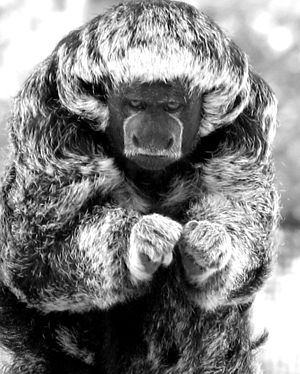Bald-faced Saki
| Bald-faced Saki | ||||||||||||
|---|---|---|---|---|---|---|---|---|---|---|---|---|

Bald-faced saki ( Pithecia irrorata ) |
||||||||||||
| Systematics | ||||||||||||
|
||||||||||||
| Scientific name | ||||||||||||
| Pithecia irrorata | ||||||||||||
| Gray , 1842 |
The bald-faced saki ( Pithecia irrorata ) is a species of primate from the New World monkey group .
features
Bald-faced sakis are medium-sized primates with long fur and a long, bushy tail. The weight of these animals is 2.1 to 2.2 kilograms, with the males being slightly heavier than the females. The shaggy fur is speckled gray on the top, the underside is black. The hands and feet are lighter in color, the bushy tail cannot be used as a prehensile tail. The face is gray in color and hairless, but partly hidden by a head of hair hanging down. The nose is very broad, the nostrils are directed outwards.
distribution and habitat
Bald-faced sakis have the southernmost distribution area of all sakis , it is located in the southwestern Amazon basin and extends roughly from the Manú National Park in Peru to the Brazilian state of Acre . Their habitat are forests, although they can occur in various forest forms - from lower-lying tropical rainforests to mountain forests.
Way of life
Not much is known about the way of life of the bald faced Sakis. They are diurnal tree dwellers who move on all fours or jumping. Like all Sakis, they are allowed to live in small groups made up of a male, a female and their offspring. Seeds and hard-skinned fruits make up the majority of their diet.
Danger
Bald-faced sakis are sometimes hunted for their meat - for example in Bolivia - and in some places they also suffer from the destruction of their habitat. Overall, the species is widespread and, according to the IUCN, not endangered ( least concern ).
literature
- Thomas Geissmann : Comparative Primatology. Springer-Verlag, Berlin et al. 2003, ISBN 3-540-43645-6 .
- Ronald M. Nowak: Walker's Mammals of the World. 6th edition. Johns Hopkins University Press, Baltimore MD 1999, ISBN 0-8018-5789-9 .
Individual evidence
- ↑ Laura K. Marsh. 2014. A Taxonomic Revision of the Saki Monkeys, Pithecia Desmarest, 1804. Neotropical Primates. 21 (1); 1-163.